Roadtrip: A tale of two cities
...My heart's in Accra 2024-08-23
Cities change over time. Communities that were organized around production of steel or auto parts or glass are now organized around finance and healthcare, tourism and universities. There’s a tendency – understandable perhaps, but pretty offensive if you ask me – to conclude that some of these old industrial cities just don’t need to exist anymore. Maybe we should just depopulate the cities that haven’t figured out how to make the transition and move everybody to the suburbs of Phoenix.
My response to that is a hearty “Fuck you!”, followed by a long rant about climate sustainability, urban density, and the idea that Great Lakes cities in particular are better positioned than most to thrive over the next 30 years. Thirty years is a long way to look, though, and I acknowledge that there are moments when it’s hard to look at a city struggling with transition and see a positive future.
One surprise from the trip is the discovery that, despite the inevitability of transformation, some things don’t change. Specifically, industrial infrastructure is way more permanent and valuable than I might have imagined. I would have simply assumed that mills and plants were being torn down across the country and turned into Amazon logistics centers and office parks. That happens, but it’s also frequently the case that a factory that made corn syrup still makes corn syrup.
Decatur, IL was built in no small part around the processing of corn and soy, and the mill built by Gene Staley is still processing corn and soy. The Staley company was bought by Britain’s Tate and Lyle, but after generations of corporate consolidation, private equity shenanigans and the machinations of modern finance, there’s a new company called Primient (Primary Products Ingredients Americas LLC) that’s basically the AE Staley company, making exactly what they’ve always made, on the outskits of Decatur. Even the colored lights that illuminate the plant remain glowing in the sky at night.
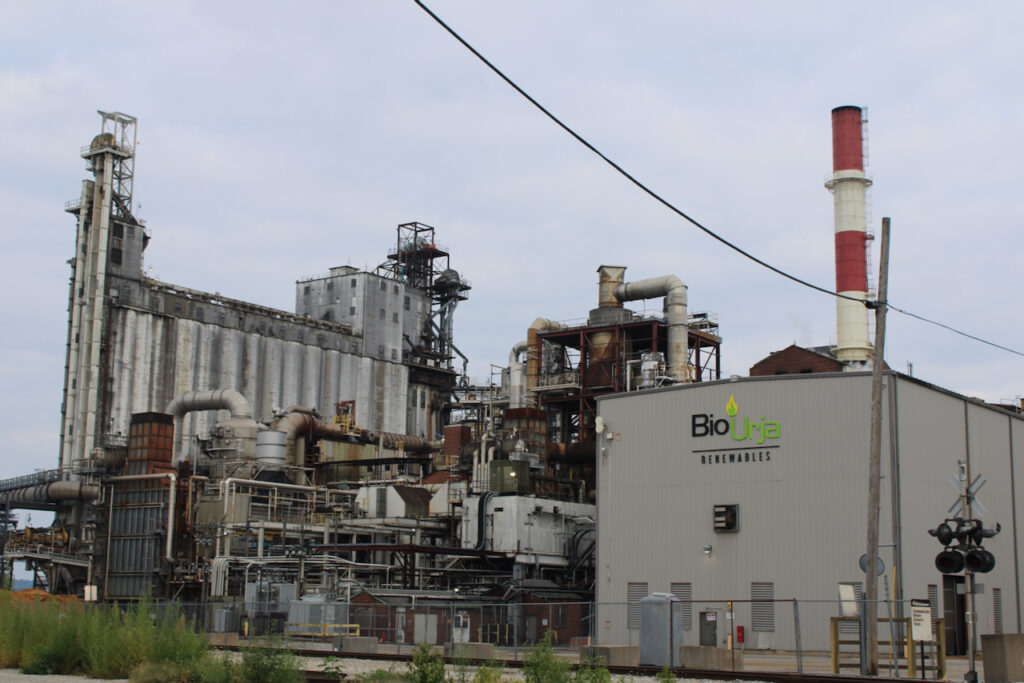
Once the Hiram Walker distillery, this plant now makes ethanol in Peoria, IL
In Peoria, the beautifully transformed waterfront runs into the factories of two core employers that have contributed to that city’s story over the years. On one bank of the Illinois River, Caterpillar manufactures “Large track-type tractors”. Across the river is the Hiram Walker distillery, built in 1934 to create mass quantities of Canadian Club to serve a thirsty post-prohibition audience. It still turns corn into alcohol, now as an ethanol plant owned by BioUrja Renewables, a Houston-based company that owns farmland, tanker services and provides ethanol to oil refiners and blenders.
Somewhere between the need for cities to change and evolve, the unalterable facts of a city’s geography and its history of industry is the possibility space in which a city can become something new. Those possible futures are constrained by geography and the past. There’s no city I’ve seen on this trip that’s done a better job of embracing that geography and history than Toledo, Ohio.
Toledo’s downtown is just a few miles from Lake Erie, connected by a navigable river (the Maumee) and its waterfront has historically been lined with glassworks, steelworks and agricultural processing, some of which still remains today. Like many de-industrialized cities, Toledo started shrinking in the 1980s and is down more than 25% from its industrial peak. You can feel that shrinkage in some parts of town, but Toledo has heavily concentrated redevelopment on its downtown and waterfronts to great effect.
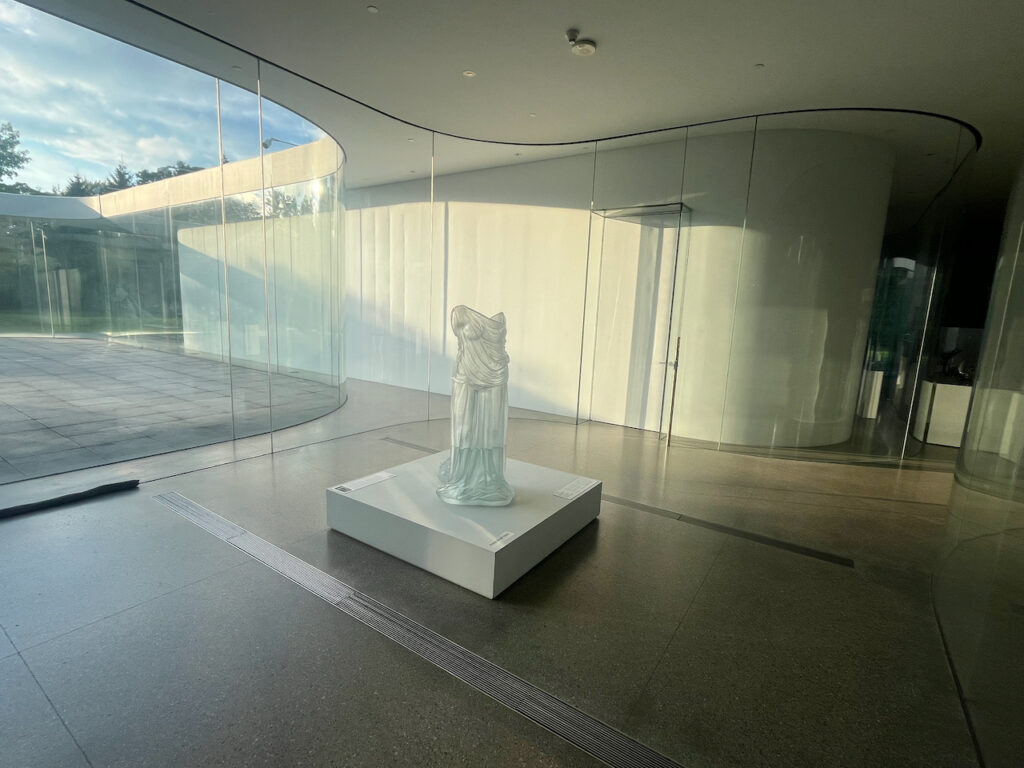
I drove in on a Saturday night stopping at the city’s excellent art museum, which is – wonderfully – open and busy until 8pm. In addition to an excellent contemporary collection, there was a mind-blowing Ethiopia exhibition tracing that country’s connections to the Arab world, Armenia and Europe, and thinking through the role of the uncolonized Ethiopian people in the Black imagination. Across a busy street is the Glass Pavilion, which is – wonderfully – made almost entirely of glass. Each exhibit space is a glass bubble, held within a larger glass bubble, a reminder that glass is perhaps the most fascinatingly beautiful and multifaceted building material. Toledo has a long history of glassblowing, based on access to supplies of sandstone and natural gas, necessary for the high temperatures needed for glassblowing. Owens-Corning developed fiberglass insulation in Toledo, and the Edward Ford Plate Glass factory developed safety glass, which became standard across automobiles worldwide. Now a sturdy glass building hosts delicate glass art from centuries past.
I followed Monroe Street from the museum a mile into the downtown, looking for a quick dinner and hoping that all the restaurants hadn’t closed at 8pm. I found the opposite problem – the nightlife was just warming up. I briefly got caught in a traffic jam behind a shuttle bus taking people between bars and a party bike, something I’d seen in tourist towns like Nashville but had not expected to encounter Toledo. I was too old, too tired and too hungry to fight my way through the bar scene and grabbed a sandwich to go. But I returned downtown Sunday morning to walk the neighborhood around Fifth Third Ballpark, home of the Toledo Mud Hens.
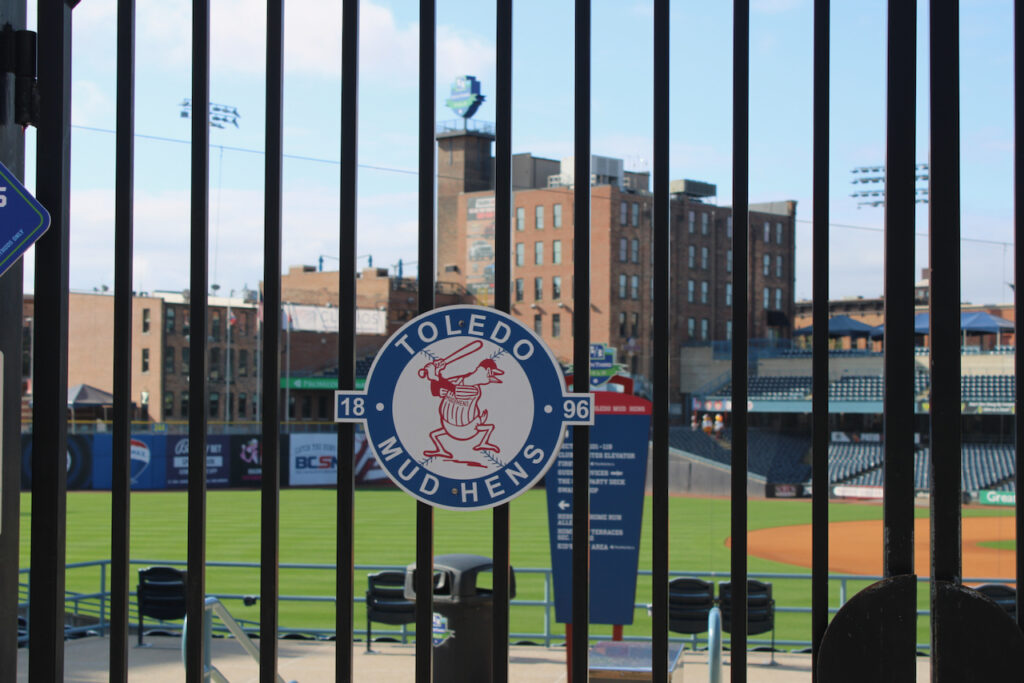
Fifth Third park, home of the Mud Hens, Toledo OH
Several blocks of downtown are clearly loved and cared for, with the predictable coffee shops and Pilates gym, several fun-looking bars and restaurants, a dog park, a hockey rink, and several other attractions I could imagine pulling people downtown. Even on a Sunday morning, there was foot traffic, but the real surprise for me came when I crossed the river to East Toledo, hoping to see the National Museum of the Great Lakes, which features historic tugs and other shipping vessels.
The museum anchors a string of parks which has to be the most impressive waterfront transformation I have ever seen. By 10:00 AM on Sunday, the place was packed with families with small kids exploring a “discovery park” featuring climbing nets leading to slides made out of industrial metal tubing. The Market Hall rented rollerblades for use on the “Glass Ribbon”, a beautifully paved outdoor skating track, mostly in use by kids on scooters. Most popular was a splash pad set by the water’s edge, not a single concrete pad with water sprays, but a carefully crafted set of shallow rivers and waterfalls that looked like tons of fun for parents and kids alike.The Glass City Metropark is part of a “green ribbon” surrounding Toledo’s waterfront trying to connect the downtown ballpark area with East Toledo into a walkable, navigable, livable river. It’s freakin’ great, and if this were a real estate blog, Toledo, particularly East Toledo, would be a strong buy recommendation for me.
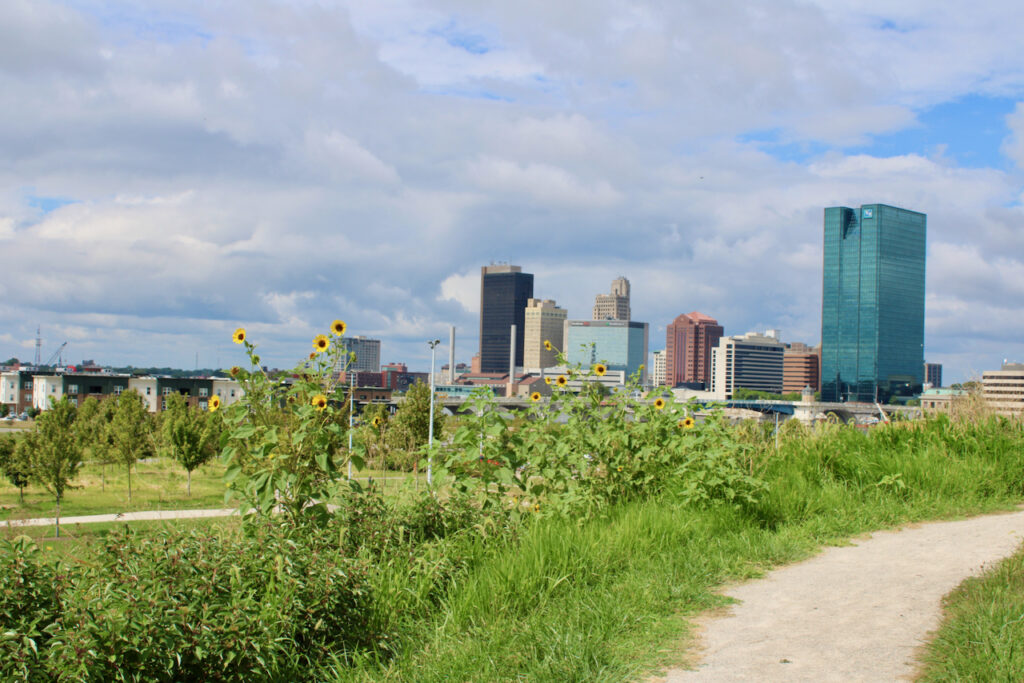
Toledo Ohio skyline from across the Maumee, at the Glass City Metropark
But instead, this is an exploration of how cities transform and what the barriers to transformation are, and I can’t get my head or heart over Gary, Indiana.
Gary is not technically on my list of “undervalued cities”. The boundaries of metropolitan statistical areas as set by the Office of Management and Budget are and will forever be beyond me. Gary is considered part of the Chicago MSA, as is Joliet, another city I’m fascinated with, presumably because Chicago is the anchor of the local economy. But Gary has a distinct personality and story from that of Chicago, and it’s a story that centers on US Steel, once the world’s largest corporation under the leadership of industrialist JP Morgan.
Gary was built atop reclaimed swampland entirely by US Steel, and named after Elbert Gary, US Steel’s chairman of the board in 1904. Jobs at US Steel drew tens of thousands of immigrants to the city, with more than 50 nationalities represented, as well as African-Americans fleeing the Jim Crow south for good-paying factory jobs. The city’s population peaked in 1960 at 178,000, 30,000 of whom were employed at Gary Works.
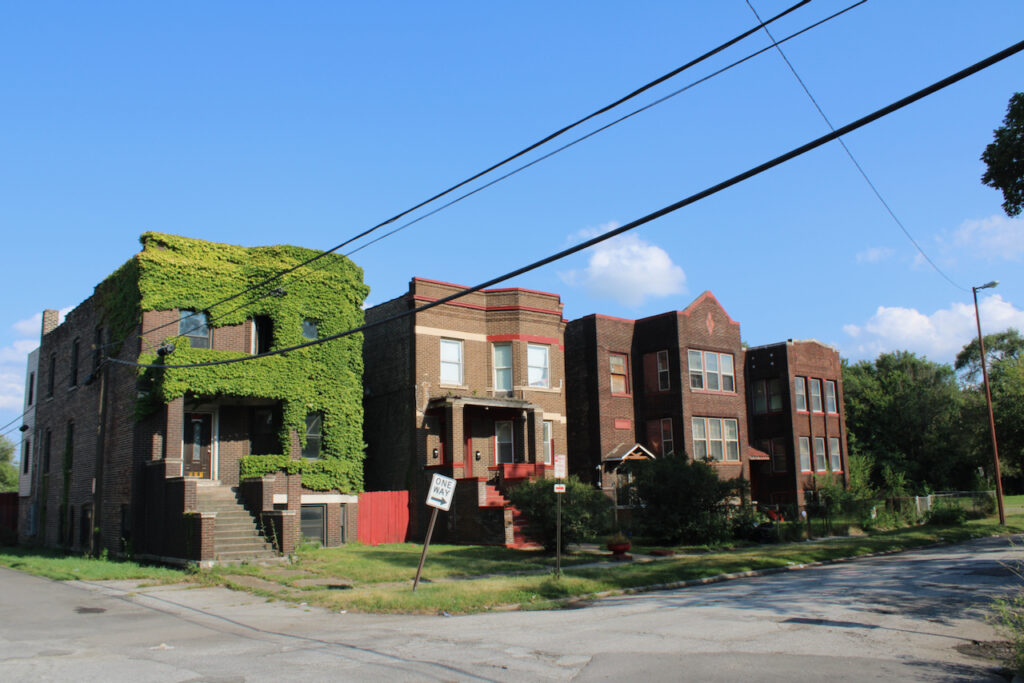
But few American cities have fallen as hard in post-industrialization as Gary. The town’s population is down to 68,000, and white flight has transformed a multiracial city into one that’s 78% African American. Median home value in Gary is $82,000, as compared to $282,000 across the US, or $305,000 in Chicago. 32% of the city’s residents are in poverty, as compared to 11.5% across the country.
When I come into an unfamiliar city on a trip like this, my first stop if it’s available is a local history museum, a visitors center or a local historical society. Almost every city has a map of architecture and sites, often put together by a local chamber of commerce – providing this sort of guidance to travelers is perhaps the bare minimum if you’re hoping to attract tourism. I followed Google Maps to the Gary Historical Society and found myself at one of the very few open establishments in the city: the public library. Upstairs in the Indiana Room, I found a curator who was in disbelief that I wanted to wander around the city. (“Most white people don’t want to exit their cars”, he told me.) We talked about Gary landmarks I might want to see, and as he mentioned historic buildings, he kept stopping to apologize – “Sorry, that burned down a few years ago.”
I’ve visited my share of blighted cities. When I started taking pictures in my own hometown, I was drawn to abandoned factories. My only published photographs are of an abandoned lime plant in Cheshire, MA, now torn down. I’m aware that ruin porn is a real thing and can get in the way of seeing a city where people still live and are looking for their individual and collective futures. I walked through Gary to less to find the picturesque buildings like the remarkable ruined City Church and more to find who was still here.
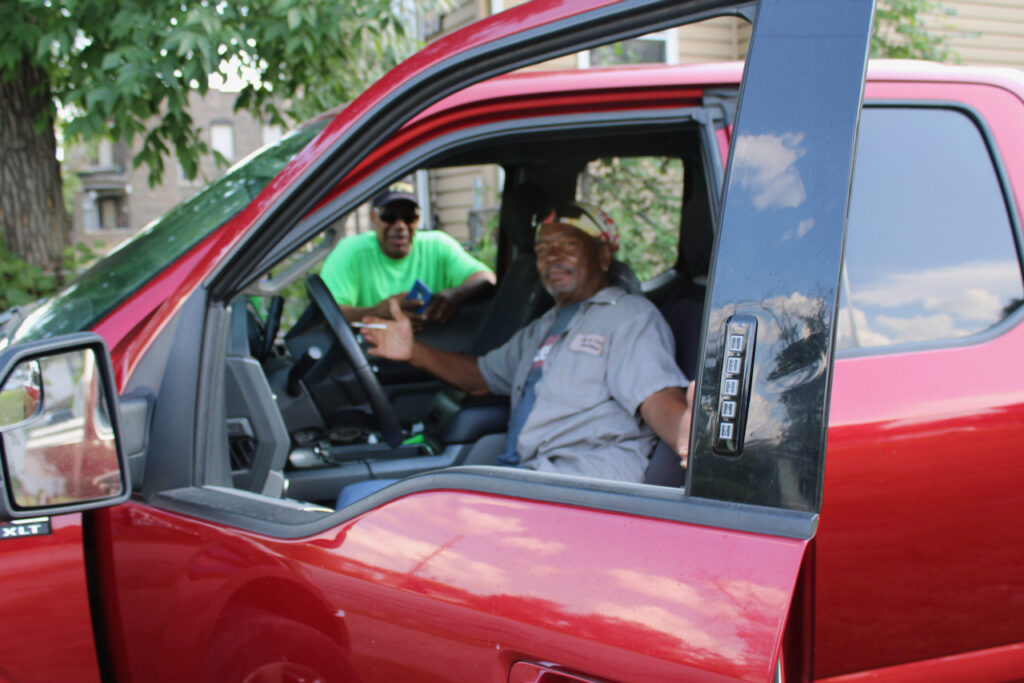
Jolly and Lamont, Gary Indiana
A few blocks from the library, I saw a shiny, expensive pickup truck and walked over to the men sitting in it. We introduced ourselves and started talking about their hopes for the city. They were optimistic that the new mayor had a vision that made sense: buildings with housing above and retail on the ground floors, a tried and true downtown revitalization strategy if you can get enough people to live downtown. A few moments into the conversation, Jolly pointed to his uniform and I saw that he was working for Gary City Demolition. We discussed whether Gary or Detroit had a worse problem of abandoned buildings. Unlike Detroit, there has not been the wave of arson in Gary, but there are many blocks where only a few homes stand in the footprint where once dozens stood.
Something I’ve not seen in any other city on this trip: Gary’s traffic lights were turned off some time ago, and every intersection now features four-way stop signs. The only exceptions are 4th and 5th streets, on which traffic speeds through as fast as possible. I didn’t see a police officer in three hours of walking and driving around the city.
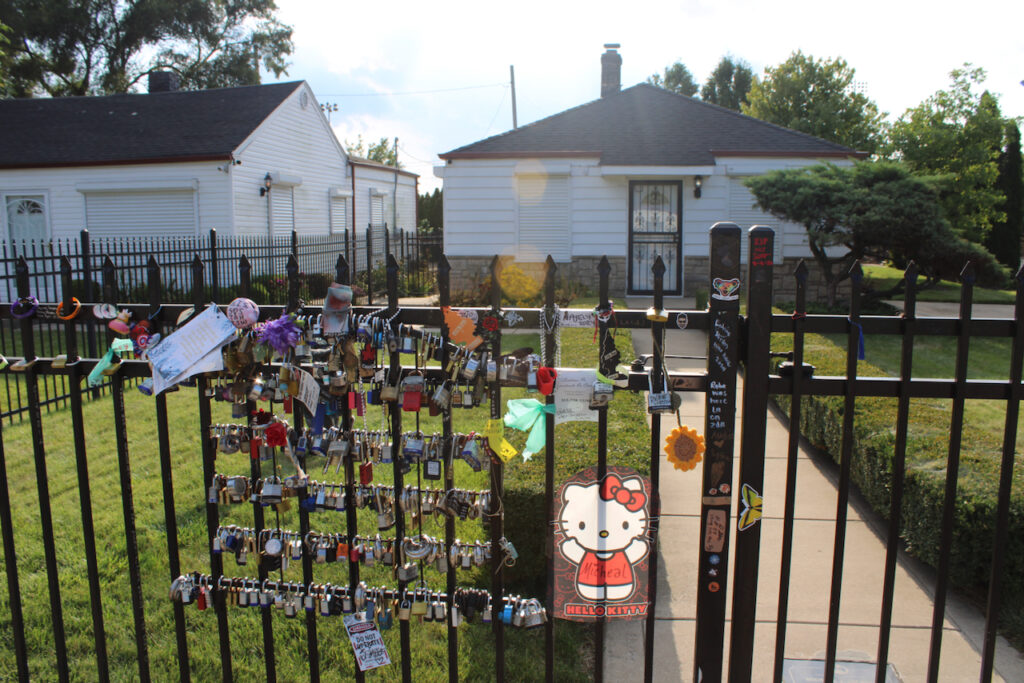
The Jackson Family Home, Gary, Indiana
One plan to revitalize Gary was to turn Michael Jackson’s boyhood home into a theme park, ala Dollywood. That hasn’t come to pass, in part due to Jackson’s declining reputation in the early 2000s. The Jackson family home is beautifully maintained and a small shrine has been assembled on the fence that surrounds it. Driving to the Jackson house, I passed through a neighborhood, no more than two or three blocks long, beautifully maintained, with signs on both ends celebrating the neighborhood association and their desire to take care of their corner of Gary.
Gary’s gone through virtually every strategy to encourage the turnaround of the downtown. There’s a casino, a revitalization strategy that rarely benefits anyone but the casino owners: it might create some low paying jobs, dealing cards or cleaning, but casinos are designed to keep visitors inside, not to circulate them through the broader town. There’s a disused convention center, less appealing now that there are no longer any nearby hotels. The end of the downtown “strip” is anchored by a minor-league ballpark, but unlike in Akron, Peoria and Toledo, there’s virtually no commercial development around it. Even on a night with the ball game, people seemed to be driving in, parking, entering the ballpark and not exploring the rest of the city.
Clearly there’s been some investment in the city:the library is beautiful and well-used, and there’s a recreation center next to the splendid City Hall. I saw young people and families heading into the rec center to work out, but most of the people I saw on the streets were elderly, and there were few places for anyone to do aside from the multi-story retirement homes.
The irony of Gary is that US Steel still exists, and, according to the curator of the Indiana room, produces as much steel as it did at its peak. However, it does so now with 3,600 workers, not 30,000, and few of them live in Gary, commuting in and out at high speed.
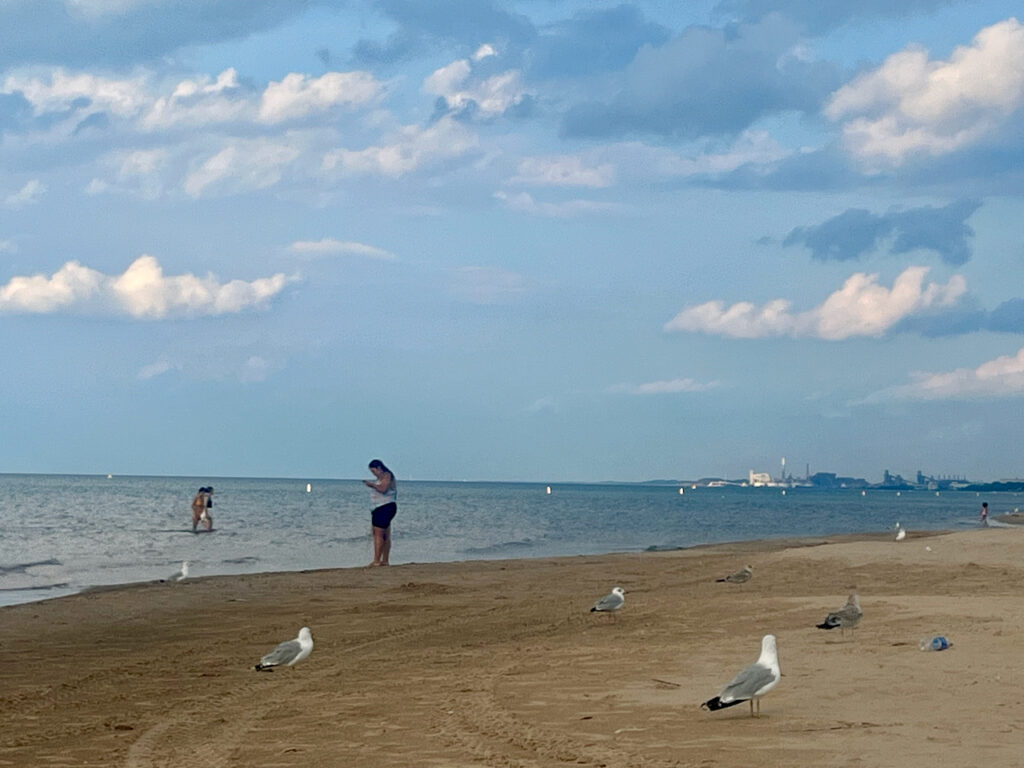
Lake Street Beach, Gary, Indiana
I wanted a view of US Steel’s miles-long plant, and drove around looking for some place I could take a photo. Eventually I found myself on a beautiful sandy beach, part of the Indiana Dunes. I had not known about the Indiana Coast, or Mount Baldy, a 600 foot sand dune that is the state’s highest point. It was an early evening and a diverse group of families were flying kites, digging holes in the sand and enjoying the waves. To my left, I could see the US Steel plant belching smoke, and to my right, Mittal Steel. In between was soft sand and placid waves off Lake Michigan.
I am a passionate optimist about the Rust Belt. I want to believe that Gary can succeed. I think of Detroit, where whole neighborhoods of a once dense city have become art installations because no one else is laying claim to or taking care of those areas. But Detroit’s downtown is now a site of investment and transformation. Detroit has more than its share of problems and figuring out how to maintain its character and yes, it’s Blackness, as it transforms economically is not going to be a simple task. But profound transformations have happened in the past.
I grew up in the distant suburbs of New York City at a time when that metropolis seemed deeply imperiled, the years of “Ford to City: Drop Dead”. When I was in high school, New York was a place where the Guardian Angels rode subway wearing motorcycle gang colors in hopes of deterring crime in a city where it’s sometimes seemed like the police had given up. My favorite part of New York, the Bronx, was literally burning during some of my childhood, but that forgotten and under-resourced place became the home of hip hop, while the Lower East Side (facing its own demons) became one of the birthplaces of punk and new wave.
What might Gary give birth to? Could we imagine a Toledo-like transformation, or has the city gone too far? Walking through Gary, I was most reminded of East St. Louis, IL, across the river from that mighty city on the Mississippi. St. Louis has its own wonderful urban mix, a shiny renovated district near a downtown ballpark, some cool restaurants lining Washington Street, but also the remarkable City Museum, which somehow re-envisioned the city’s industrial past as playground. Down by the water, a stretch of levee wall has been offered up as a paradise for graffiti writers, the Mural Mile.
St. Louis is already a city with neighborhoods that are – for now – depopulated and perhaps abandoned, and so its sister across the river feels like a ghost town. It’s got its requisite riverboat casino and some fine (though now crumbling) architecture, but it’s virtually impossible to find an open business or a place to eat, as I found in Gary. If the cities are caught between the possibility of reinvention and the infrastructure of the past, there may be a moment of no return, a moment where the architecture that is such a treasure has collapsed like City Church. I hold hope that Gary might transform, but it’s tempered with the sadness that it may be too late.
The trip so far: Driving by Data Set By the numbers: What statistics can and can’t tell you about undervalued cities A Square Deal in Binghamton Buried, with dignity, in Elmira Side Quest in northern Ohio In search of the “statistically improbable restaurant” Decatur – From corn to soy to crickets? Peoria to Kankakee Utica Starts with You
The post Roadtrip: A tale of two cities appeared first on Ethan Zuckerman.